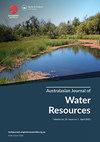Murray-Darling Basin Plan mark II. What should stakeholders plan for?
IF 2.2
Q2 WATER RESOURCES
引用次数: 5
Abstract
ABSTRACT The revised Murray-Darling Basin Plan is scheduled for 2026. Given the Plans complexity, and issues involved in the revision it is worth asking what will be the main drivers of change? What changes can reasonably be anticipated? What preparations should stakeholders make for their engagement in the planning process? As we move towards the next Basin Plan, there are multiple wheels in motion that could shape the future. Several factors we anticipate being important are examined. Our aim is to stimulate stakeholders to think about and prepare for major contingencies that could affect their interests. We focus on those that will likely affect water availability, and changes in policy and water-governance by public agencies. We take the starting point that rivers are complex social-ecological systems, within which structural circumstances and forms of social capital will affect individuals’ and communities’ abilities to maximise what they achieve from their natural assets, and their resilience to unfavourable contingencies. We conclude with some observations about how stakeholders might strengthen their ability to respond to opportunities or threats. While the future is always uncertain and all planning processes are flawed, how stakeholders conceive of and respond to today’s challenges will substantially affect their capacity to be resilient.墨累-达令盆地计划II。利益相关者应该计划什么?
本文章由计算机程序翻译,如有差异,请以英文原文为准。
求助全文
约1分钟内获得全文
求助全文
来源期刊

Australasian Journal of Water Resources
WATER RESOURCES-
CiteScore
5.10
自引率
21.90%
发文量
25
期刊介绍:
The Australasian Journal of Water Resources ( AJWR) is a multi-disciplinary regional journal dedicated to scholarship, professional practice and discussion on water resources planning, management and policy. Its primary geographic focus is on Australia, New Zealand and the Pacific Islands. Papers from outside this region will also be welcomed if they contribute to an understanding of water resources issues in the region. Such contributions could be due to innovations applicable to the Australasian water community, or where clear linkages between studies in other parts of the world are linked to important issues or water planning, management, development and policy challenges in Australasia. These could include papers on global issues where Australasian impacts are clearly identified.
 求助内容:
求助内容: 应助结果提醒方式:
应助结果提醒方式:


